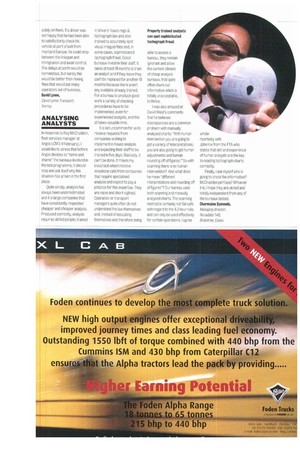ANALYSING ANALYSTS
Page 25

If you've noticed an error in this article please click here to report it so we can fix it.
In response to Roy McCrudden, fleet services manager at Argos (CM3-9 February), I would like to stress that before Argos decides to "name and shame" the bureaux involved in the test programme, it should stop and ask itself why this situation has arisen in the first place.
Quite simply, analysis has always been underestimated and it is large companies that have consistently requested cheaper and cheaper analysis. Produced correctly, analysis requires skilled people; trained in drivers hours regs tachograph law and also trained to accurately spot visual irregularities and, in some cases, sophisticated tachograph fraud. Good bureaux invest in their staff. It takes at least 18 months to train an analyst and if they leave they can't be replaced for another 18 months because there aren't any available already trained. For a bureau to produce good work a variety of checking procedures have to be implemented, even for experienced analysts, and this all takes valuable time.
It is not uncommon for us to receive requests from companies wishing to implement in-house analysis and expecting their staff to be trained in five days. Basically, it can't be done. It makes my blond boil when I receive telephone calls from companies that require specialised analysis and expect to pay a pittance for this expertise. They are naive and short-sighted. Operation or transport managers quite often do not understand the law themselves and, instead of educating themselves and therefore being able to assess a bureau, they remain ignorant and allow the current climate of cheap analysis bureaux, that quite often churn out information which is totally unacceptable, to thrive.
I was also amazed at David West's comments that he believes discrepancies are a common problem with manually analysed charts: "With human intervention you are going to get a variety of interpretations; you are also going to get human adjustments and human rounding off of figures." So with scanning there is no human intervention? And what does he mean "different interpretations and rounding off of figures"? Our bureau uses both scanning and manually analysed charts. The scanning method is certainly not fail-safe with regard to the 4.5 hour rule, and can only be used effectively for certain operations. I agree
whole
heartedly with John Nix from the FTA who states that skill and experience of human analysts are the key to reading tachograph charts correctly.
Finally, lash myself who is going to check the information? McCrudden perhaps? Whoever it is, I hope they are skilled and totally independent from any of the bureaux tested.
Charmaine Symonds, Managing director.
Alovadata TAB, Braintree, Essex.












































































































